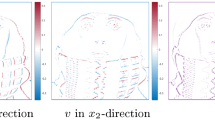Abstract
The aim of this paper is to propose new regularization and filtering techniques for dense and sparse vector fields, and to focus on their application to non-rigid registration. Indeed, most of the regularization energies used in non-rigid registration operate independently on each coordinate of the transformation. The only common exception is the linear elastic energy, which enables cross-effects between coordinates. Cross-effects are yet essential to give realistic deformations in the uniform parts of the image, where displacements are interpolated.
In this paper, we propose to find isotropic quadratic differential forms operating on a vector field, using a known theorem on isotropic tensors, and we give results for differentials of order 1 and 2. The quadratic approximation induced by these energies yields a new class of vectorial filters, applied numerically in the Fourier domain. We also propose a class of separable isotropic filters generalizing Gaussian filtering to vector fields, which enables fast smoothing in the spatial domain. Then we deduce splines in the context of interpolation or approximation of sparse displacements. These splines generalize scalar Laplacian splines, such as thin-plate splines, to vector interpolation. Finally, we propose to solve the problem of approximating a dense and a sparse displacement field at the same time. This last formulation enables us to introduce sparse geometrical constraints in intensity based non-rigid registration algorithms, illustrated here on intersubject brain registration.
Similar content being viewed by others
References
L. Alvarez, J. Weickert, and J. Sánchez, “Reliable estimation of dense optical flow fields with large displacements,” Int. J. of Comp. Vision, Vol. 39, No. 1, pp. 41–56, 2000.
R. Bajcsy and S. Kovačič, “Multiresolution elastic matching,”Comp. Vision, Graphics and Image Processing, Vol. 46, pp. 1–21, 1989.
P. Blomgren and T.F. Chan, “Color tv: Total variation methods for restoration of vector valued images,” IEEE Trans. Image Proc., Vol. 7, No. 3, pp. 304–309, 1996.
M. Brady and B.K.P. Horn, “Rotationally symmetric operators for surface interpolation,” Comp. Vision, Graphics, and Image Processing, Vol. 22, pp. 70–94, 1983.
P. Cachier, E. Bardinet, D. Dormont, X. Pennec, and N. Ayache, “Iconic feature based nonrigid registration: The PASHA algorithm,” Comp. Vision and Image Underst., Vol. 89, Nos. 2/3, pp. 272–298, 2003.
P. Cachier, J.-F. Mangin, X. Pennec, D. Rivière, D. Papadopoulos-Orfanos, J. Régis, and N. Ayache, “Multisubject non-rigid registration of brainMRIusing intensity and geometric features,” in Proc. of MICCAI'01, Vol. 2208 of LNCS, Utrecht, the Netherlands, 2001, pp. 734–742.
V. Casalles, G. Sapiro, and D.-H. Chung, “Vector median filters, inf-sup operations, and coupled PDE's: Theoretical connections,” J. Math. Imaging and Vision, Vol. 8, pp. 109–119, 2000.
M.H. Davis, A. Khotanzad, D.P. Flamig, and S.E. Harms, “A physics-based coordinate transformation for 3D image matching,” IEEE Trans. on Medical Imaging, Vol. 16, No. 3, pp. 317–328, 1997.
R. Deriche, “Recursively implementing the Gaussian and its derivatives,” in 2nd Int. Conf. on Image Processing, 1992, pp. 263–267.
J. Duchon, “Interpolation des fonctions de deux variables suivant le principe de la flexion des plaques minces,” RAIRO Analyse Numérique, Vol. 10, No. 12, pp. 5–12, 1976.
M. Gabrani, “Multidimensional spline interpolation theory and surface-based alignment of brains,” PhD thesis, Drexel University, Philadelphia, USA, 1998.
P. Hellier, C. Barillot, E. Mémin, and P. Pérez, “Medical image registration with robust multigrid techniques,” in Proc. of MICCAI' 99, Vol. 1679 of LNCS, Cambridge, UK: Springer, 1999, pp. 680–687.
H. Jeffreys, “On isotropic tensors,” Proc. of Cambridge Phil. Soc., Vol. 73, pp. 173–176, 1973.
P. Kannappan and P.K. Sahoo, “Rotation invariant separable functions are Gaussian,” SIAM J. on Math. Analysis, Vol. 23, No. 5, pp. 1342–1351, 1992.
R. Kimmel, R. Malladi, and N. Sochen, “Images as embedded maps and minimal surfaces: Movies, color, texture, and volumetric medical images,” Int. J. Comp. Vision, Vol. 39, No. 2, pp. 111–129, 2000.
R. Lakes, “Foam structures with a negative Poisson's ratio,” Science, Vol. 235, No. 4792, pp. 1038–1040, 1987.
M. Nielsen, L. Florack, and R. Deriche, “Regularization and scale space,” Research Report RR-2352, INRIA, 1994.
D. Rey, G. Subsol, H. Delingette, and N. Ayache, “Automatic detection and segmentation of evolving processes in 3D medical images: Application to multiple sclerosis,” in Proc. of IPMI'99, Vol. 1613 of LNCS, Visegrad, Hungary, 1999, pp. 154–167.
D. Rivière, J.-F. Mangin, D. Papadopoulos, J.-M. Martinez, V. Frouin, and J. Régis, “Automatic recognition of cortical sulci using a congregation of neural networks,” in Proc. of MICCAI' 00, Vol. 1935 of LNCS, Pittsburgh, USA: Springer, 2000, pp. 40–49.
K. Rohr, M. Fornefett, and H.S. Stiehl, “Approximating thinplate splines for elastic registration: Integration of landmark errors and orientation attributes,” in Proc. of IPMI'99, Vol. 1613 of LNCS, Visegrád, Hungary: Springer, 1999, pp. 252–265.
G. Sapiro and D.L. Ringach, “Anisotropic diffusion of multivalued images with applications to color filtering,” IEEE Trans. Image Proc., Vol. 5, No. 11, pp. 1582–1586, 1996.
G.F. Smith, “On isotropic tensors and rotation tensors of dimension m and order n,” Tensor, N. S., Vol. 19, pp. 79–88, 1968.
R. Szeliski, “Bayesian modeling of uncertainty in low-level vision,” Int. J. of Comp. Vision, Vol. 5, No. 3, pp. 271–301, 1990.
D. Terzopoulos, “Regularization of inverse visual problems involving discontinuities,” IEEE Trans. on Pattern Analysis and Machine Intelligence, Vol. 8, No. 4, pp. 413–424, 1986.
A. Tsai, A.Yezzi, and A.S.Willsky, “Acurve evolution approach to medical image magnification via the Mumford-Shah functional,” in Proc. of MICCAI'00, Vol. 1935 of LNCS, Pittsburgh, USA: Springer, 2000, pp. 246–255.
H. Weyl, The Classical Groups: Their Invariants and Representations, Princeton University Press, 1966.
Author information
Authors and Affiliations
Rights and permissions
About this article
Cite this article
Cachier, P., Ayache, N. Isotropic Energies, Filters and Splines for Vector Field Regularization. Journal of Mathematical Imaging and Vision 20, 251–265 (2004). https://doi.org/10.1023/B:JMIV.0000024042.88755.4f
Issue Date:
DOI: https://doi.org/10.1023/B:JMIV.0000024042.88755.4f




